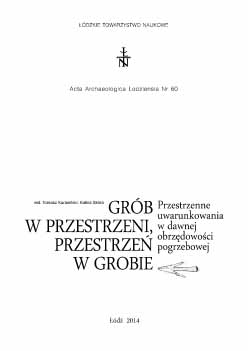Naczynia ceramiczne i wiaderka klepkowe z wczesnopiastowskiego cmentarzyska w Sowinkach k. Poznania
Ceramic vessels and stave buckets from an early Piast cemetery in Sowinki near Poznań
Author(s): Andrzej KrzyszowskiSubject(s): Archaeology
Published by: Łódzkie Towarzystwo Naukowe
Keywords: Sowinki; the Early Middle Ages; skeletal burial; clay vessels; wooden stave buckets
Summary/Abstract: Two clay vessels and eleven to twelve stave buckets with iron hoops were discovered in Sowinki, in a skeletal flat cemetery with two phases of use that dates back to the fourth quarter of the 10th to the first half of the 12th century. They were found in burials of three people aged iuvenis of unspecified gender (objects no. 61, 148, 151), one person aged iuvenis /adultus, also of unknown gender (object no. 70), four people aged adultus, including two women (objects no. 7 and 138) and two men (objects no. 44 and 76), probably one man aged maturus (object no. 176). The age and gender of four of the remains (objects no. 10B, 23, 157 and 182) could not be determined due to poorly preserved bone fragments (objects No. 10B, 157 and 182), or their total absence (object No. 23). In all of the graves, the vessels were individually placed nearby the feet of the deceased, usually to his or her left. In most of the burials, they were found in the direct vicinity of the deceased, within the grave pit, or even directly inside the clear outlines of the coffin. Only in three cases, in the graves where traces of coffins were registered, did the buckets clearly lie beyond them. Following the typological division proposed by G. Arwidsson and L. Holmquist (1986, p. 238), the stave buckets from Sowinki represent two morphological types among this kind of objects. The eleven buckets belong to the first type (group A according to the authors), were made with the use of cooperage techniques, with handles, iron rims and a movable iron bail handle. The majority of objects have a slight conical form, with a noticeable enlargement at the bottom, with a diameter in the range of 14-18 cm and the preserved height of 11-14 cm, the initial height ranging from 13 to 16 cm. A variant of this type is represented by a single object only, the bucket discovered in burial no. 138. Carrying similar features as the buckets of A1 variant, it is of a larger size with a diameter of about 22 cm, whereas the height of the bucket could have originally been about 18-20 cm.
Journal: Acta Archaeologica Lodziensia
- Issue Year: 2014
- Issue No: 60
- Page Range: 137-158
- Page Count: 22
- Language: Polish

